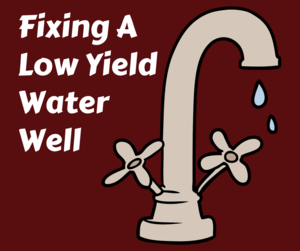CALL TODAY 1-800-441-6281
CALL TODAY 1-800-441-6281

No Water? Troubleshooting Dry Water Well Problems
The two words any water professional or homeowner never wants to hear are, “dry well”. Maybe it’s because as a homeowner you have no control over a well going dry or maybe it’s because it may mean big money to repair or replace it.
A dry well affects everything you do, from cooking and cleaning to personal hygiene. Until recently, many water professionals rarely saw a dry well. But as drought conditions continue in various places across the country, they’re starting to see more, especially in the western US. With less rainfall out west, and reduced annual no snow pack in the Northeast, there is less water reaching and replenishing aquifers.
Drilling a new well is costly. Here is some information about how to troubleshoot your well so you can make an informed decision if you think your well has gone dry.
Some Early Warning Signs
A dry well doesn’t happen overnight. There are usually some pretty clear signs like:
Significant air bubbles in the water
- Running out of water after heavy use (like a long shower, or watering the lawn)
- Pump isn’t producing as much water as it did
- Pump runs for longer than usual before shutting off
- Water pressure is low
- Takes some time to build up water pressure
- Your neighbors are also having water problems
While these are strong signals there may be a problem, they do not necessarily indicate a dry well.
Dry Well or Pump Failure?
Most well water contractors are above board, however, some take a “get the new one drilled and the old one filled” attitude when it comes to a dry well. There are many problems that may seem to be a dry well, but may be fixable. Always get a second opinion before making a major decision, like hydrofracturing, well deepening or well replacement. A reliable specialist will always perform tests to diagnose your problem, before drilling.
For example, air bubbles in the water could mean your well is drying out, or it could simply be a pinhole in the pipe, or a bad check valve. The only way to tell is to pull the pump and inspect the well. Spending a few hundred dollars to examine and repair your system is always better then investing thousands in a new well. And who knows, it may be something as common as an electrical problem.
What’s Happening Under Ground?
Pump size, flow rate and horsepower all affect the drawdown in your well. The static water level of your well is the water level is when your pump is at rest. When your pump begins sending water out of the well, in most “dry well” cases this happens at a rate that is faster than the well’s ability to recover. This can result in air in the water or running out of water while the sprinklers are running. This is known as “pumping down”.
What Can I Do Now?
Just because your well is pumping down, it doesn’t mean you need a new one. You have alternatives including:
- Reducing water use
- Setting the pump deeper
- Improving appliances water efficiency
- Waiting for the aquifer to recharge
- Hydrofracturing
- Drilling deeper or replacing the well
The bottom line is that even in the event you have a “dry well” there are options short of drilling a new well. While some, like waiting for the aquifer to recharge, may seem impractical or longer-term, others, like well deepening and setting your pump deeper, that can achieve results at a lower cost than drilling a new well. Speak with a well water professional at Skillings & Sons. They have been in the water well business for forty years and can troubleshoot your well, and provide you with a list of options.

